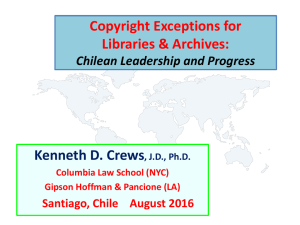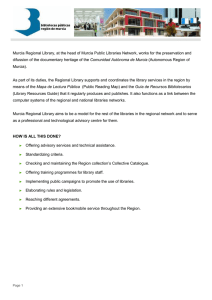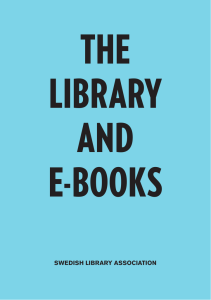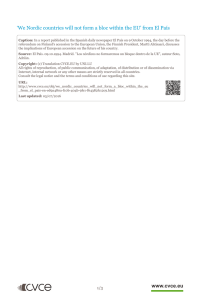The Finnish National Digital Library: National Library of Finland
Anuncio
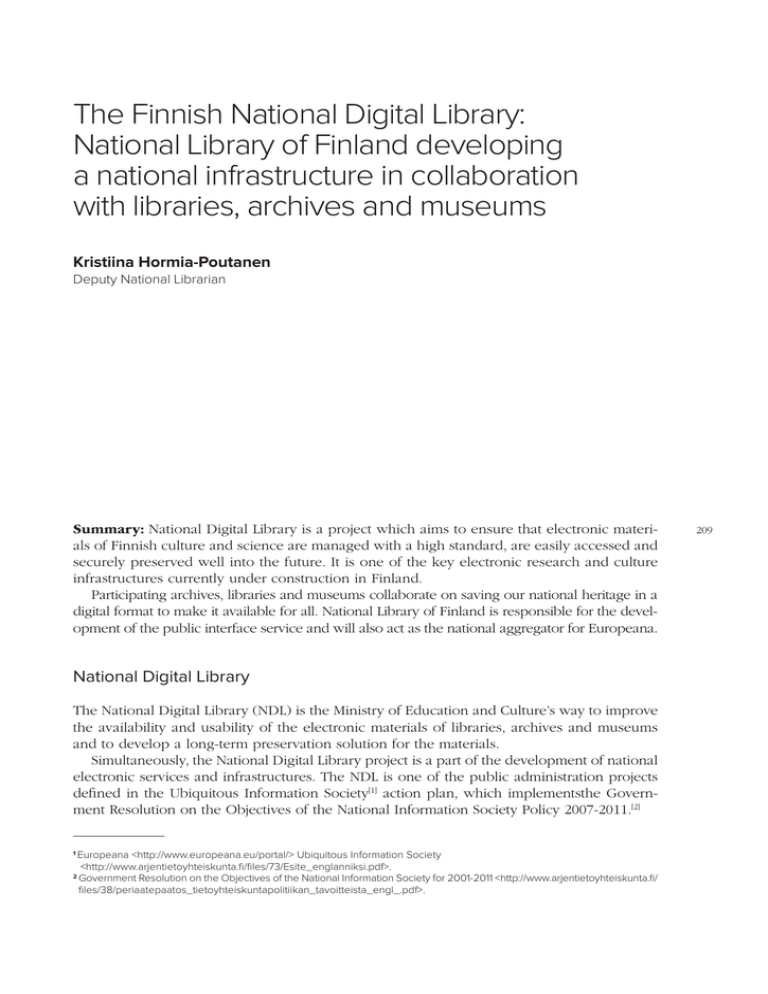
The Finnish National Digital Library: National Library of Finland developing a national infrastructure in collaboration with libraries, archives and museums Kristiina Hormia-Poutanen Deputy National Librarian Summary: National Digital Library is a project which aims to ensure that electronic materials of Finnish culture and science are managed with a high standard, are easily accessed and securely preserved well into the future. It is one of the key electronic research and culture infrastructures currently under construction in Finland. Participating archives, libraries and museums collaborate on saving our national heritage in a digital format to make it available for all. National Library of Finland is responsible for the development of the public interface service and will also act as the national aggregator for Europeana. National Digital Library The National Digital Library (NDL) is the Ministry of Education and Culture’s way to improve the availability and usability of the electronic materials of libraries, archives and museums and to develop a long-term preservation solution for the materials. Simultaneously, the National Digital Library project is a part of the development of national electronic services and infrastructures. The NDL is one of the public administration projects defined in the Ubiquitous Information Society[1] action plan, which implementsthe Government Resolution on the Objectives of the National Information Society Policy 2007-2011.[2] Europeana <http://www.europeana.eu/portal/> Ubiquitous Information Society <http://www.arjentietoyhteiskunta.fi/files/73/Esite_englanniksi.pdf>. 2 Government Resolution on the Objectives of the National Information Society for 2001-2011 <http://www.arjentietoyhteiskunta.fi/ files/38/periaatepaatos_tietoyhteiskuntapolitiikan_tavoitteista_engl_.pdf>. 1 209 Mesa redonda. Cooperación con archivos, museos, audiovisuales y otras instituciones y organizaciones en proyectos digitales The project aims to ensure that the information of our culture, heritage and history is safely stored, easily found and actively used. This will benefit learning and research and offer new possibilities for the creative industries and artists. One target is also to improve the productivity of the participating organisations. The joint solution reduces the overlapping costs of digitisation, management and distribution of electronic materials, releasing resources for other tasks and consequently making the use of public funds more effective. At the same time, the impact benefits gained from the creation and maintenance of library, archive and museum information resources will multiply as the materials form a common, easy-to-use national entity. The Ministry of Education and Culture has appointed both an executive committee and a steering group for the National Digital Library. The board of the National Library of Finland has appointed a consortium group to the steer the development of the public interface service (Fig.1). 210 Figura 1. Governance Model of the National Digital Library Enterprise architecture Enterprise architecture work of the National digital library was launched in March 2009 and completed at the beginning of March 2010. This document describes the project’s enterprise architecture (EA) using the EA architecture design method for Finnish government.[3] The document is being updated in 2012. The project’s enterprise architecture describes how the various elements–organisational units, people, processes, information and information systems–relate to each other and function as a whole (Fig. 2). Enterprise architecture is subdivided into four areas: business architecture, data architecture, application architecture and technical architecture. Business architecture describes the project’s services, stakeholders and processes. Data architecture describes the key glossaries being used, the central information resources and the relationship between information categories and systems. Application architecture describes the content of the information system portfolio. Technical architecture describes the technology portfolio, reference architectures and interfaces. The National Digital Library – Enterprise Architecture <http://kdk.fi/images/stories/tiedostot/NationalDigitalLibrary_ EnterpriseArchitecture.pdf>. 3 The Finnish National Digital Library: National Library of Finland developing a national infrastructure ... Figura 2. Enterprise architecture of NDL The standard portfolio appended to the document contains key information from the EA perspective. The portfolio defines the standards used in the project and describes the grounds given for incorporating them as part of the enterprise architecture. 211 Public interface The public interface of the National Digital Library is a shared online service of Finnish libraries, archives and museums that ensures access to their printed and electronic resources and services. The National Library of Finland is responsible for developing forms of cooperation in the network of libraries, archives and museums as well as for creating the NDL public interface service. At the beginning of 2012, the National Library decided that the public interface will be based on Open Source (OS) software. Choosing OS will promote national and international collaboration in developing the interface. The public interface will be created through several rounds of development (using the agile development method) together with the archives, libraries and museums. The first round in 2012 will involve the construction of features according to the requirement specifications. The second round will include further development of the service and the addition of new functions according to the organisations’ needs. The development will be overseen and coordinated by the National Library of Finland, which allows its clients to follow the development process, contribute to it and provide feedback according to the principles of agile software development. The new software solution has enabled rapid progress to be made and most of the functions have already been implemented. The first demonstrations presented the deduplication, the processing of component parts, the visualisation of the archive hierarchy and various other features. These convinced the participants that the end result would meet their high expectations. Figura 1. Governance Model of the National Digital Library Mesa redonda. Cooperación con archivos, museos, audiovisuales y otras instituciones y organizaciones en proyectos digitales Figura 3. Public interface architecture 212 The public interface architecture consists of several modules (Fig. 3). The public interface Finna is aimed to be launched in 2012. The National Library is responsible for the coordination, development and maintenance of the service and it enables its customers to follow the development and give input according to the principles of the agile development model. The National Library also acts as a central service unit that is further responsible for the training of the network of archives, libraries and museums. The so-called first wave of customers will start to use the public interface during late 2012. The first wave consists of ten organisations, among which the three sectors are represented. The first implementation of Finna will give an idea how the full service will function and look. In the first implementation, there will be about 10 million records. Once all NDL organisations are in production, there will be about 100 million records. Preparations for the second wave will begin in 2012, but the actual installation, training and implementation of customised organisational user interfaces will start at the beginning of 2013. There will be dozens of organisations representing the three sectors in the second wave. Later on, new organisations will be gradually incorporated. A paradigm shift: from closed systems to open solutions For some time, a paradigm shift has been occurring in the development of data systems both in Finland and abroad. This shift will allow the expanded use of open-source software, making it the best option in many cases. Open-source solutions have often emerged when no appropriate off-the-shelf software has been available for a specific purpose. The most widely known and significant open-source solutions include the various distributions of the Linux operating system, the Apache web server software, the MySQL database and the Firefox web browser. The potential of open source has also been recognised in Finnish national policies. To quote the current Government Programme: “In the context of procurement, a technology-neutral approach will be applied to open- and closed-source software.” In addition, the Advisory Committee on Information Management in Public Administration has issued a recommendation ( JHS-169) on the use of open-source software in public adminis- The Finnish National Digital Library: National Library of Finland developing a national infrastructure ... tration. The National Library has extensive experience using open-source software in its core operations. Finnish online material is harvested or archived automatically using the Heritrix software developed by various important national libraries such as the Library of Congress and the National Library of France. Many commercial service providers also use Heritrix. Due to the fairly small and heterogeneous body of Heritrix users, commercial software has not been an attractive option. The digital repository services Doria and Theseus are also based on an open-source platform and serve more than 30 higher education institutions and other organisations. To ensure the development of the DSpace system, a non-profit organisation has been established. Development work is undertaken not only by the community of users, but also by the maintenance organisation, using voluntary financial contributions and service charges. DSpace has achieved an important position among digital repository platforms. The decision to use open source solutions in the development of the Public is in accordance with Finnish national policies.It also facilitates national and international cooperation in the development. Collaboration with Libraries, Archives and Museums The increase and intensification of cooperation between organisations has been discernible right from the beginning of the project. Convergence has taken place both between the library, archive and museum sectors and within each individual sector. Cooperation between sectors has its roots in two areas: in the planning of joint services, as well as in the added value created for users when different materials become accessible via a single service. Intensifying cooperation between sectors is motivated by an easier and more efficient use of joint services, as systems, description rules and other practices become more uniform. To date, the NDL is the most extensive cooperation project between libraries, archives and museums in Finland. Its impact will be visible in many ways in the operation of these organisations. The development of the NDL requires commitment and partnership. As system services are developed jointly, it also provides a better basis for finding joint solutions to other challenges in the operating environment. Over the years of activity everyday collaboration between the three domains has become very active. People have also learned to know each other, which makes cooperation easier. In addition to the development of the public interface, all sectors have started projects to improve the metadata production and quality within their sector. There are links between these projects. National Digital Library and public libraries The services public libraries offer in Finland are considered among the most important public sector services in the country. The public library sector has been involved in the development of the National Digital Library public interface from the beginning. There are three public libraries among the first wave of the public interface implementation and more public libraries are represented in the second wave. 213 Mesa redonda. Cooperación con archivos, museos, audiovisuales y otras instituciones y organizaciones en proyectos digitales National aggregator for Europeana Europeana, the European Digital Library, <www.europeana.eu>[4], constitutes a common view of European cultural heritage. The digitised materials of libraries, archives and museums form the key content of Europeana. It is a joint project of the European Union Member States and the European Commission. The National Digital Library project is participating in the development of Europeana. In the future, metadata on Finnish materials will be relayed to Europeana via the national aggregator of the National Digital Library. References Europeana – Explore Europe’s Cultural Collections URL <http://www.europeana.eu/portal/>. The National Digital Library – Enterprise Architecture URL <http://kdk.fi/images/stories/tiedostot/ NationalDigitalLibrary_EnterpriseArchitecture.pdf>. Ubiquitous Information Society Advisory Board – Government Resolution on the Objectives of the National Information Society for 2001-2011 URL <http://www.arjentietoyhteiskunta.fi/ files/38/periaatepaatos_tietoyhteiskuntapolitiikan_tavoitteista_engl_.pdf>. Ubiquitous Information Society Advisory Board – Ubiquitous Information Society URL <http://www.arjentietoyhteiskunta.fi/files/73/Esite_englanniksi.pdf>. 214 4 Europeana <http://www.europeana.eu/portal/>.



